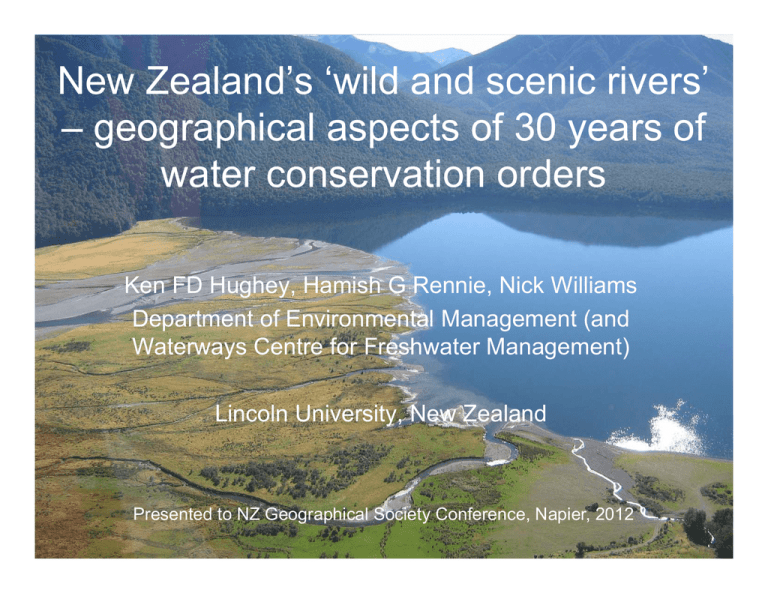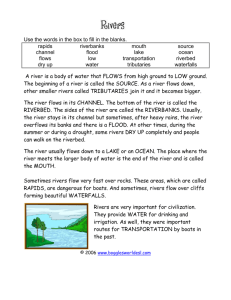New Zealand’s ‘wild and scenic rivers’ water conservation orders
advertisement

New Zealand’s ‘wild and scenic rivers’ – geographical aspects of 30 years of water conservation orders Ken FD Hughey, Hamish G Rennie, Nick Williams Department of Environmental Management (and Waterways Centre for Freshwater Management) Lincoln University, New Zealand Presented to NZ Geographical Society Conference, Napier, 2012 Background and Purpose • ‘Wild and Scenic Rivers’ a part of NZ’s freshwater management since 1981 • But, since 1981 only 15 water bodies have been gazetted in a country renowned for its outstanding rivers and lakes • Only in 2012 has a dedicated website been launched around WCOs in NZ: http://www.outstandingrivers.org.nz/ • There is ongoing political controversy around the benefits and costs of having the legislation and the status – is it necessary, is it limiting ‘development’? • Purpose of this presentation: – Review the historical and contemporary geography of WCOs in NZ – Describe the outcomes achieved – Identify the extent to which WCOs are conflicting or not with development The ‘lead up’ to WCOs in NZ • 1941 Soil Conservation and Rivers Control Act – first Act to require planning ‐ no environmental components • 1967 Water and Soil Conservation Act – introduced catchment plans but limited environmental input and no cultural component • 1960s & 70s – environmental awakening in NZ, culminating in Save Manapouri Campaign – petition signed by 264,907 NZers • 1970s ‐ Environmental demands increased – NZ Salmon Anglers applied for a water right for salmon: denied • Pressure led to a ‘Wild and Scenic Rivers’ campaign – culminated in the Water and Soil Conservation Amendment Act 1981 – the so‐ called ‘Wild and Scenic Rivers’ legislation. Key aspects of WCOs in NZ • Aims to recognise the outstanding amenity or intrinsic values that water provides, in either a natural or modified state. • Orders may be applied over rivers, lakes, streams, wetlands, or aquifers, and can cover freshwater or geothermal water. • If granted, can restrict or prohibit water ‘takes’, discharges and other uses of the water. • Can be used to preserve natural state or protect characteristics such as: – the water body's value as a habitat or fishery – its wild and scenic nature – its value for recreational, historic, spiritual, cultural or scenic purposes. • A water body may also hold particular significance for Māori. WCOs in New Zealand North Island WCO rivers and lake Motu River Mohaka River Rangitikei River Blue duck Manganuiotea o Lake Wairarapa Buller Grey SI WCO rivers and lake Rangitata Rakaia Ahuriri Te Waihora – Lake Ellesmere: NZ’s 5th largest lake by area; over half of all NZ native bird spp recorded there Mataura River Oreti River Kawarau Classifying outstanding features of WCOs Multiple terms to describe nationally outstanding features – we combined terms where they apply to the same feature, e.g., • ‘wild and scenic’ seldom used - sometimes scenic alone is recorded • native birds referred to mostly as wildlife, but also as particular species, i.e., blue duck and black-billed gill • recreational (salmonid) fisheries referred to as back country fisheries, spawning grounds, salmon, brown trout, rainbow trout, etc – grouped as recreational fisheries. No whitebait fisheries • all references to native fisheries tagged to specific species, e.g., koaro or long-finned eel – all considered native fisheries. a b Tikanga Māori Spiritual/ cultural ‐ European Historical Kayaking Rafting Jet boating Recreational and other boating Boating Native flora Native birds Scientific Hydro geological Natural character Gazettal year 1984 1988 1989 1989 1990 (2010) 1990 1991 Wild & scenic Water body Motu Rakaia Lake Wairarapa Manganuioteao Te Waihora/ Lake Ellesmere Ahuriri Grey Native fisheries Native flora and fauna Natural features Recreational fisheries Nationally Outstanding features in WCOs c N 1 4 1 3 4 2 2 The WCOs above were all first gazetted prior to the Resource Management Act 1991 Rangitikei Kawarau Mataura Buller Motueka Mohaka Rangitata Oreti 1993 1997 1997 2001 (2008) 2004 2004 2006 2008 N 9 4 1 4 11 3 1 11 2 3 6 6 2 1 4 5 11 1 7 5 5 11 4 Observations about values protected • Prior to 1991 average of 2.4 (Range = 1-4) outstanding features; post RMA average 5.8 (Range = 1-11) • Most rivers recognised for native bird features also recognised for their recreational fisheries • Only one non salmonid angling recreational feature recognised <1991 - jet boating on Rakaia; since 1991 this activity & kayaking (in particular) recognised in several Orders • Also, >1991, more orders recognising Tikanga Māori values • Neither swimming nor whitebaiting have been recognised in any of the orders. Sections of NI rivers covered by WCOs Source: Parliamentary Commissioner for the Environment (2012) Sections of SI rivers covered by WCOs Source: Parliamentary Commissioner for the Environment (2012) Types of orders gazetted • Preservation – protecting river or lake and outstanding features in their natural state • Multiple use – almost all forms of development can occur subject to meeting strict requirements for protection of the outstanding features – includes water quality, fish passage and minimum flow regimes • Limited multiple use – only some forms of development, e.g., water abstraction and some discharges to water can occur, but must meet strict requirements for protection of outstanding features; – almost always there would be a no damming part of this criterion. Protection regime imposed on WCOs Water body Natural features Native flora and fauna Outstanding features Rec. fisheries Rec. and other boating Historical/ socio cultural ‐ European Tikanga Māori Natural state Protection regime imposed Limited multiple Multiple use use Motu Upper Mid Rakaia Upper Main stem Lake Wairarapa Manganuioteao Te Waihora/ Lake Ellesmere Ahuriri Grey Rangitikei Kawarau Mid to lower Lake margins Upper Main stem Upper Grey; Ahaura Ahaura Mid‐Upper Upper tribs Lake Main stem Mataura Buller Main stem Mid to lower Upper tribs & lakes Main stem Motueka Mohaka Rangitata Oreti Upper Main stem Upper Mid Upper Mid Lake margins & levels Mid to lower Upper Mid Whole Mid to lower Mid to lower Discussion General observations, from N=15 orders: • Recent orders recognise and protect a wider range of outstanding features, esp. non-angling recreation, historic, socio-cultural European interests, and Tikanga Māori values, e.g., Te Waihora/Lake Ellesmere: – When first gazetted in 1990 recognised only for outstanding wildlife habitat, – But in 2010 upon review, diversity of outstanding values increased to also include wetland vegetation habitat, native fisheries and Tikanga Māori. • Most common values recognised are native bird and/or recreational fisheries. Thus, 11 out of 15 gazetted orders, due to their recognition of native birdlife, contributing directly to the conservation of New Zealand’s indigenous biodiversity. Are WCOs preventing development? Generally, ‘no’ • • • Higher parts of catchments (e.g., tributaries of Lake Wakatipu, itself a tributary of the Kawarau, and tributaries of the Buller), subject to provisions around preserving in their natural state. Middle reaches - frequently a ‘mixed multiple use’ regime - restrict damming but provide for other forms of development so long as these do not compromise outstanding features. Dams disastrous most outstanding river features and thus limits included in most, if not all, river WCOs. Lakes and the lowland sections of rivers embed a multiple use water resource management regime into their regulatory framework. – involves inclusion of minimum flow regimes, fish passage requirements, and defined water quality conditions – WCO designed to meet requirements of outstanding features being protected, but at the same time provide for existing irrigation (e.g., Rangitata) and potential major future irrigation (e.g., Rakaia). Conclusions • Since 1981 15 orders have been gazetted, seven in the period 1981 until the passage of the RMA in 1991; and eight since. • Only two Orders successfully applied for since 1991 passage of RMA, i.e., Oreti and Rangitata. • Above finding raises important questions, e.g., have WCOs already been gazetted for many of NZ’s most important ‘wild and scenic’ rivers or, is the WCO process too expensive and litigious for applicants or, are other planning mechanisms under the RMA achieving similar or better results? • Existing orders, mostly, do not appear to significantly compromise ‘wise’ water resource development, except some from a hydro perspective – so, from a development context what is the govt’s concern about promoting them further? Is there a future for WCOs in NZ? • Current government appears anti WCOs and sees them as a development threat – but, as shown in this paper there is little evidence of such being the case • The public has little or no understanding of WCOs and does not see them as the NPs of rivers • Until 2012 there wasn’t even an up to date inventory of NZ’s WCOs, or even a WCO website – there is now • So, given the above, and the costs associated with WCO applications and other issues there seems little likelihood of any further WCO applications in the near term – ‘why fix it if it ain’t broken’?



